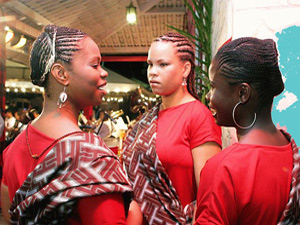Keeping Black culture alive in Brazil
By Fabiana Frayssinet | Last updated: Dec 11, 2009 - 9:21:41 PMWhat's your opinion on this article?

Afro-Brazilian girls during a Candomblé ceremony. Photo: WikiMedia Commons
November 20 was National Black Awareness Day in Brazil, in commemoration of the Nov. 20, 1695 death of the leader of Black resistance in Brazil, Zumbi dos Palmares. In some Brazilian states, including Rio de Janeiro and Sao Paulo, Nov. 20 is a holiday aimed at ‘reflection on the insertion of Blacks in Brazilian society.' |
“I would define ‘quilombos' as resistance by Black people, as their essence,” Vagner do Nascimento, president of the Association of Residents of Campinho da Independencia, tells IPS.
Situated to the southwest of the city of Rio de Janeiro, less than 20 miles from the town of Paraty in the middle of lush jungle that forms part of the Mata Atlântica (Atlantic forest), Campinho—as it is referred to by the people who live here—is one of the 3,524 quilombos distributed throughout Brazil, according to the Culture Ministry's Palmares Cultural Foundation.
However, independent sources say there are 1,500 more quilombos—which were originally remote villages or collections of villages founded by runaway slaves, often hidden in the jungle.

|
After slavery was abolished on May 13, 1888, many quilombos became villages, where people depended on subsistence agriculture and small-scale trade.
“Our main reference point is the Zumbi dos Palmares Quilombo,” says Mr. Nascimento. “For us, the ‘quilombolas,' as the people living in these places were known, are the synonym, you could say, of a society that did well for itself.”
Zumbi dos Palmares was a famous colonial period quilombo located in the Serra da Barriga mountains in what is today the northern state of Alagoas.
Palmares, which defended its freedom for over a century and at one point was home to as many as 50,000 escaped slaves, became a symbol in the fight against slavery in Brazil.
“People there lived and worked together, and consolidated their own values. That's why Palmares is a really strong reference point for us, because here in Campinho the land is collectively owned, and we have collective forms of producing, of generating culture, of working,” says Mr. Nascimento.
Campinho has a unique history. Its 80 or so families descend from just three slave women: Antonia, Marcelina and Luiza. And according to the history that was orally transmitted from generation to generation, they weren't just “ordinary” slaves, but came from the “Big House” and had culture and education.
As the story goes, shortly after the abolition of slavery, the landowners of the three haciendas in the region distributed the property to their former slaves and left.
Antonia, Marcelina and Luiza “gathered all the dispersed slaves together and brought them here with them,” says a member of the fifth generation of descendants, Laura María dos Santos, Campinho's head of educational and cultural projects.
“This heritage is transmitted to our girls, who become women who know what their role is,” says Ms. dos Santos. She goes on to tell an anecdote: “When a man made a sexist remark, his niece, a girl from our community, said ‘uncle, in a woman's land, the woman never dies'.”
Nor do the women in this community want their cultural heritage to die. The local residents association led by Ms. Nascimento is carrying out projects for the recuperation of the historical memory, craftsmaking, ethnic tourism, and the revival and sustainable production of traditional crops like cassava, rice, beans and corn.
Campinho was the first quilombo in the state of Rio de Janeiro to obtain a formal collective land ownership title, on March 21, 1999, after a struggle that began in the 1960s.
On one hand, the creation of the Bocaína National Park kept them from hunting and collecting fruits in the forest—activities they depended on for a living.
In addition, the construction of the Rio de Janeiro-to-Santos stretch of the BR-101 highway, between 1970 and 1973, drove up land prices and led to property speculation in the area.
The entire Paraty region became the target of interest on the part of large tourism ventures, and many people began to sell and leave their lands.
Those who stayed, like the community of Campinho, eventually won their battle. But other battles emerged, like the struggle for coexistence with a new touristy world of “rich people,” and the effort to preserve the local culture, says Ms. dos Santos.
“It's a question of continuing to fight for our ethnic and traditional identity, while at the same time incorporating the technology to which young people have a right,” she adds.
On the other hand, as “Auntie Albertina” adds, there are other problems, like the fact that many of the local families have ended up working in nearby tourist condominiums.
“Soon, no one is going to want to work the land anymore,” laments the old woman, who says she would never give up her land, where she grows beans and rice, makes cachaça—a Brazilian liquor made from distilled sugar cane juice—and is her own boss.
The haciendas in the region produced homemade cachaça since the time of the three original slave women.
Referring to the women working outside the community, Silvia says “they see the rich women with their styles and want to imitate them. They have a nice house, but when they see their bosses home, they start to suffer, because they want one just like it.”
Another challenge is adopting new technologies, to which the children and young people in Campinho have access, generally in internet cafés, without forgetting their culture and traditional values.
According to Silvia, “there's no formula for how to do that,” other than raising awareness in the community about the importance of keeping the culture alive.
The women see access to technologies like the Internet, community radio stations and video cameras as important, to be able to record their history and culture.
But the challenge is “to dominate technology, and not let technology dominate us.”
“We teach our youngsters that the worst sin is to let themselves be enslaved by anything,” she says.
Silvia moved away from the community when she was a little girl, and later became a community leader in a favela in Rio de Janeiro, where she went to live, like so many other quilombolas.
Her fear is that the quilombos will go down the road followed by the favelas and become mere shantytowns without proper infrastructure or sanitation, due to a lack of space to expand. As the local families grow, and the land is increasingly subdivided, the houses are more and more crowded together.
She recalls that many of the crowded favelas surrounding Rio and other cities today used to be areas similar to the quilombos, with gardens, open areas and natural water sources.
That is why she wants the government to grant more land to the descendants of the original escaped slaves, who argue that they have a right to the property.
“The houses have to be spaced out, so that if a woman fights with her husband, no one can hear,” Silvia jokes.
Campinho is also involved in ecological projects. “Although some environmentalists say the opposite, the best-preserved areas are the ones where the quilombolas live,” she argues.
The projects include the sustainable production of palm hearts and agroforestry. “First we feed the community, and later, we sell what's left over, outside,” says Daniele.
“Auntie Albertina,” who the younger people in the community listen to with respect, speaks up again.
“On my plot of land I don't let anyone kill even a little bird,” she says, recalling that in the past, her ancestors even ate toucans to survive, but pointing out that the birds have made a comeback in the surrounding jungle, which she calls “a great achievement.”
The people of Campinho have other collective subsistence activities, such as the sale of traditional crafts in tourist areas of Paraty, and a restaurant that specializes in typical Afro-Brazilian dishes, like “feijoada,” a stew of black beans, pork and beef, which was traditionally made with what was left over after the master's family was served.
The community also has an ethnic tourism project, giving tours of the community that include visits to the old “senzala” or slave compound, the cassava flour production areas, and the community garden, as well as hikes in the jungle and cultural activities like traditional dance recitals.
November 20 was National Black Awareness Day in Brazil, in commemoration of the Nov. 20, 1695 death of the leader of Black resistance in Brazil, Zumbi dos Palmares
In some Brazilian states, including Rio de Janeiro and Sao Paulo, Nov. 20 is a holiday aimed at “reflection on the insertion of Blacks in Brazilian society.”
With Blacks officially making up half of the population of Brazil, the country has the second largest Black population in the world, after Nigeria.
For Vagner do Nascimento, the leader of the community, there is no doubt: the question is to “survive with dignity. That is the essence of Black people in Brazil today, whose ancestors were brought over from Africa.”
Related news:
Blacks will soon be Brazil’s majority (FCN, 05-27-2008)
INSIDE STORIES AND REVIEWS
-
-
About Harriett ... and the Negro Hollywood Road Show
By Rabiah Muhammad, Guest Columnist » Full Story -
Skepticism greets Jay-Z, NFL talk of inspiring change
By Bryan 18X Crawford and Richard B. Muhammad The Final Call Newspaper @TheFinalCall » Full Story -
The painful problem of Black girls and suicide
By Charlene Muhammad -National Correspondent- » Full Story -
Exploitation of Innocence - Report: Perceptions, policies hurting Black girls
By Charlene Muhammad -National Correspondent- » Full Story -
Big Ballin: Big ideas fuel a father’s Big Baller Brand and brash business sense
By Bryan Crawford -Contributing Writer- » Full Story






 Click Here Stay Connected!
Click Here Stay Connected!








